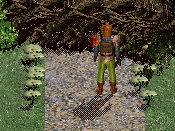Depth-Dot - what does it do?
Sprites with a lower y coordinate than tge dot of the other will be drawn behind the sprite. It's also from where the coordinates of a sprite is counted with all commands such as move() and sp_x().
Ah, thanks! So it also affects at which point the sprite can't go over tile hardness?
I'm not really familiar with all the depth-dot does, but I'd say yes.
"Ah, thanks! So it also affects at which point the sprite can't go over tile hardness?"
Among other things, yes
Among other things, yes
Another interesting thing it does is affect where the sprite's dialogues will appear in relation to the sprite.
Really? It would be a case of "Dialogue appears x amount above depth dot", correct? I didn't know that... 
"Really? It would be a case of "Dialogue appears x amount above depth dot", correct? I didn't know that..."
Yep, and you can use sp_strength and sp_defense to change that x amount, too
"If the active_sprite is a text sprite (sp_brain of 8), the strength value is the x-offset of the text from the parent sprite's sp_x coordinate. By default it is set to 75, so the text starts 75 pixels left of the parent sprite."
"If the active_sprite is a text sprite (sp_brain of 8), the defense value stores the y-offset of the text from the parent sprite's sp_y coordinate. By default it is set to 100 plus a value related to the depth dot and hardbox, so the text appears roughly 100 pixels above the sprite's head."
Yep, and you can use sp_strength and sp_defense to change that x amount, too
"If the active_sprite is a text sprite (sp_brain of 8), the strength value is the x-offset of the text from the parent sprite's sp_x coordinate. By default it is set to 75, so the text starts 75 pixels left of the parent sprite."
"If the active_sprite is a text sprite (sp_brain of 8), the defense value stores the y-offset of the text from the parent sprite's sp_y coordinate. By default it is set to 100 plus a value related to the depth dot and hardbox, so the text appears roughly 100 pixels above the sprite's head."
That is weird - why would the strength and defense alter the position of dialogue? The only reason I can imagine is that big monsters tend to have great strength and defense, but it still seems silly.
Anyhow, are depth dots stored in "SET_SPRITE_INFO" or in the numbers after "load_sequence"?
Anyhow, are depth dots stored in "SET_SPRITE_INFO" or in the numbers after "load_sequence"?
"That is weird - why would the strength and defense alter the position of dialogue? The only reason I can imagine is that big monsters tend to have great strength and defense, but it still seems silly."
Strength and defense of the text sprite itself, not of the sprite that's talking.
"Anyhow, are depth dots stored in "SET_SPRITE_INFO" or in the numbers after "load_sequence"?"
Both, hardbox too. SET_SPRITE_INFO will override the numbers after load_sequence though. If you look in the DinkC Reference under Techniques there's a good detailed explanation of those numbers and general .INI, depth dot stuff.
Strength and defense of the text sprite itself, not of the sprite that's talking.
"Anyhow, are depth dots stored in "SET_SPRITE_INFO" or in the numbers after "load_sequence"?"
Both, hardbox too. SET_SPRITE_INFO will override the numbers after load_sequence though. If you look in the DinkC Reference under Techniques there's a good detailed explanation of those numbers and general .INI, depth dot stuff.
Hmmm, I'd never thought of text as being a sprite. This is most interesting news.
Yep. For example, you can get at the title "1.08" text by doing a get_sprite_with_this_brain() for the text brain. I don't think the text-as-sprite avenue is fully explored yet. Does it have a hardbox? If so, can you give it touch_damage? Can you use functions from the move()-family on it? Can you make the text say something? Have the text follow Dink around? What happens if you hurt() a text?
You can access the sprite number of the last spoken text by a given sprite with busy() (though read dinkc.chm for a caveat).
Go nuts
You can access the sprite number of the last spoken text by a given sprite with busy() (though read dinkc.chm for a caveat).
int &textspr = busy(&spritenum);
Go nuts
"You can access the sprite number of the last spoken text by a given sprite with busy()"
Why would you do it like that? Surely it's easier to just do:
Or use &last_text.
And I don't think you can do much with the sprite At least I've tried things like changing the size... the rest sounds interesting though if it's possible!
At least I've tried things like changing the size... the rest sounds interesting though if it's possible!
Why would you do it like that? Surely it's easier to just do:
int &textspr = say("talktalktalk", &sprite);Or use &last_text.
And I don't think you can do much with the sprite



























